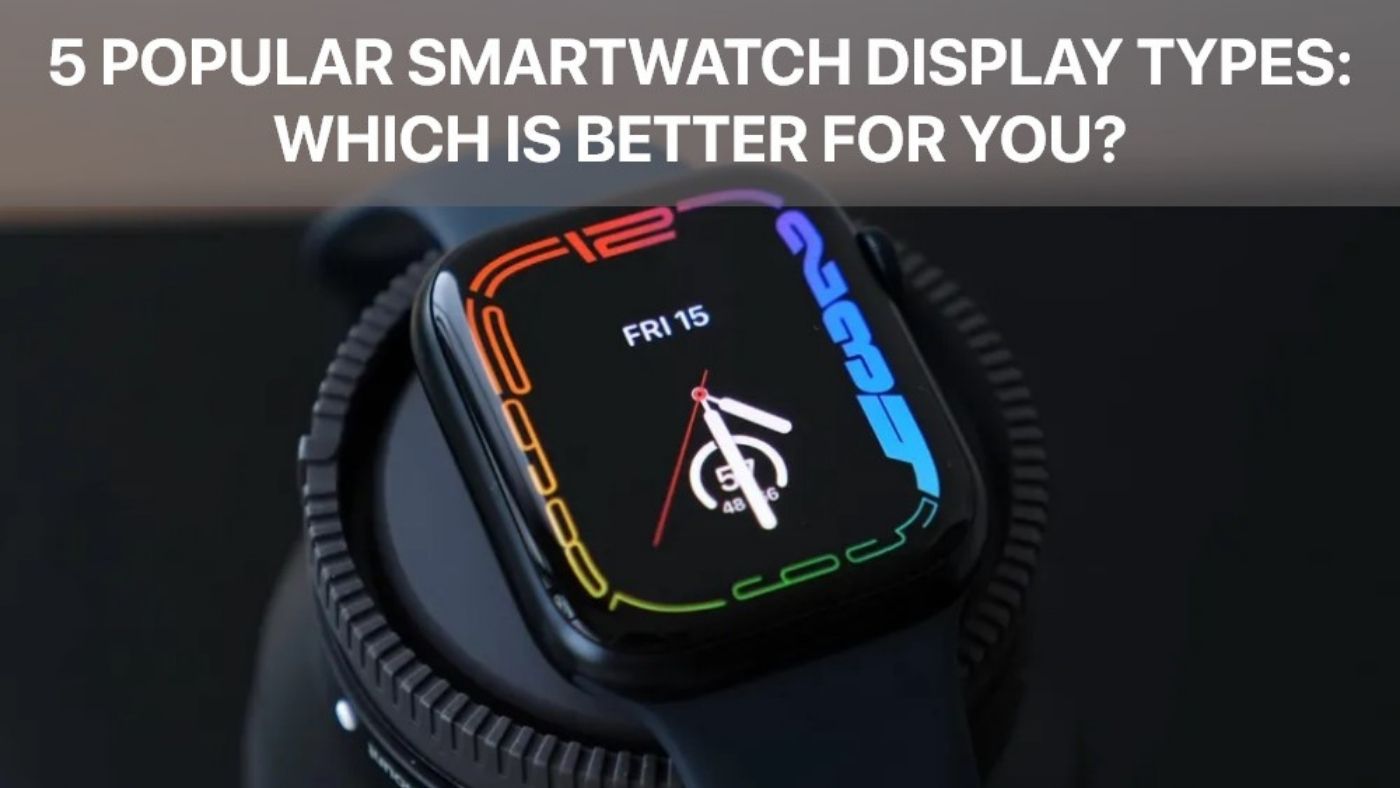Types of smartwatch displays range from very simple to highly complex and offer a variety of features and options. If you're in the market for a new smartwatch, it's important to understand the differences between each type of display before making your purchase. This guide will help you decide which display is right for you.
Types of Smartwatches Display
Following are the types of smartwatches display:
AMOLED Display in Smartwatches

AMOLED stands for Active Matrix Organic Light Emitting Diode. This technology offers several advantages over other types of displays. First, AMOLED displays are extremely thin and light, making them ideal for use in wearable devices.
Second, they're very power efficient, so they won't drain your battery as quickly as other types of displays. Finally, they offer superior image quality, with deep blacks and vibrant colors. If you're looking for a smartwatch with a sharp, clear display, an AMOLED-equipped model is definitely worth considering.
Pros of AMOLED Display
- One of the main advantages is that it uses very little power, which is essential for a device that needs to be worn all day.
- Another benefit is that it can be made very thin and light, which is also important for a wearable device.
- The high contrast ratio and wide range of colors offered by AMOLED mean that it can produce a very sharp and vibrant image.
Cons of AMOLED Display
- One of the main disadvantages is the cost. AMOLED displays are typically more expensive than other types of displays, making them less affordable for many consumers.
LCD Display in Smartwatches

LCD displays offer a number of advantages over traditional watch faces, including brighter colors, sharper images, and low power consumption. In addition, LCD displays are often smaller and lighter than traditional watch faces, making them more comfortable to wear.
And because they don't use mechanical components, they're much less likely to break down. For all these reasons, LCD displays are an excellent choice for smartwatches.
Pros of LCD Display
- One key advantage is that LCDs use very little power, which is important in a device that needs to be worn all day long.
- Another advantage is that LCDs are highly readable in both direct sunlight and low-light conditions. This is due to the fact that LCDs emit their own light, unlike OLED displays, which require an external backlight.
- Finally, LCDs are generally less expensive to produce than OLEDs. For these reasons, LCDs are a popular choice for smartwatch displays.
Cons of LCD Display
- One of the biggest drawbacks is that LCDs can't be viewed in direct sunlight, making them difficult to read in bright conditions.
- In addition, LCDs tend to use more power than other types of displays, which can shorten battery life.
TFT LCD in Smartwatches

TFT LCDs (Thin-Film-Transistor Liquid-Crystal Displays) are a type of flat panel display that use two sheets of glass with a liquid crystal material sandwiched in between. The glass sheets are coated with a grid of tiny electrical conductors, which are used to apply an electric field to the liquid crystals.
The crystals align themselves in response to the electric field, and by carefully controlling the field, it is possible to create images on the screen. TFT LCDs are the most common type of display used in smartwatches due to their high image quality and low power consumption.
However, they are also relatively fragile and can be easily damaged if dropped.
Pros of TFT LCD Display
- These screens offer a number of advantages over traditional watch displays, including a more vibrant color palette, higher resolution, and wider viewing angles.
- TFT LCDs also consume less power than other types of watch displays, making them ideal for use in battery-powered devices such as smartwatches.
- In addition, TFT LCDs are highly durable and resistant to scratches and other damage.
Cons of TFT LCD Display
- TFT LCDs tend to suffer from image retention, meaning that images can "burn in" to the screen over time.
Transflective LCD in Smartwatches

One type of LCD, known as transflective LCD, is now commonly used in smartwatches. This type of LCD is designed to offer the best of both worlds when it comes to visibility and power consumption.
The display is able to reflect light from the environment, making it easier to see in direct sunlight. At the same time, the LCD contains a backlight that can be used in low-light conditions. As a result, transflective LCDs offer excellent visibility and Power efficiency, two important factors for any smartwatch.
Pros of Transflective LCD Display
- More visible in sunlight than traditional LCDs
- More power efficient
- It can be made thinner and lighter
Cons of Transflective LCD Display
- One of the biggest disadvantages is that transflective LCDs are much more difficult to view in direct sunlight. This can be a major issue for smartwatches, which are often used outdoors.
E-Ink Display in Smartwatches

The E-Ink display is a display technology that is used in electronic devices such as Smartwatches. This display technology enables the Smartwatch to have a clear and visible display even in direct sunlight.
The E-Ink display is also power efficient which helps to increase the battery life of the Smartwatch. This display technology uses tiny microcapsules that contain black and white particles.
These particles are arranged in a way that they can reflect light which helps to create the images on display. The E-Ink display is also flexible, which means it can be used in different types of Smartwatches.
Pros of E-Ink Display
- This display technology uses a layer of Electrophoretic ink, which consists of tiny particles that can be moved around by an electric field. This allows the display to show images while using very little power.
- In addition, E-Ink displays are always on, so you don't have to worry about conserving battery power by turning off your watch.
- Another advantage of E-Ink displays is that they're very easy to read in direct sunlight. They also offer excellent contrast and can even be read in low-light conditions.
- The potential downside is that E-Ink displays are not well suited for displaying color images.
Which smartwatch display type is better for you?

When choosing a smartwatch, one of the most important decisions you'll have to make is which type of display to choose. There are several different types of smartwatch displays on the market, each with its own advantages and disadvantages. AMOLED displays are known for their excellent brightness and contrast levels, making them easy to read in all lighting conditions.
However, they tend to be more expensive than other types of displays. LCD displays are a more affordable option, but they don't offer the same high level of quality as AMOLED displays.
TFT LCD displays offer a good compromise between price and quality, while Transflective LCD Displays are a good choice for those who need to conserve battery life. E-Ink Displays are perfect for those who want an always-on display that is easy on the eyes. Ultimately, the best display type for you will depend on your needs and budget.
Conclusion
With all of the different types of smartwatch displays on the market, it can be hard to determine which one is best for you. Hopefully, this article has helped you understand the differences between each type and decide which display is right for your needs.



